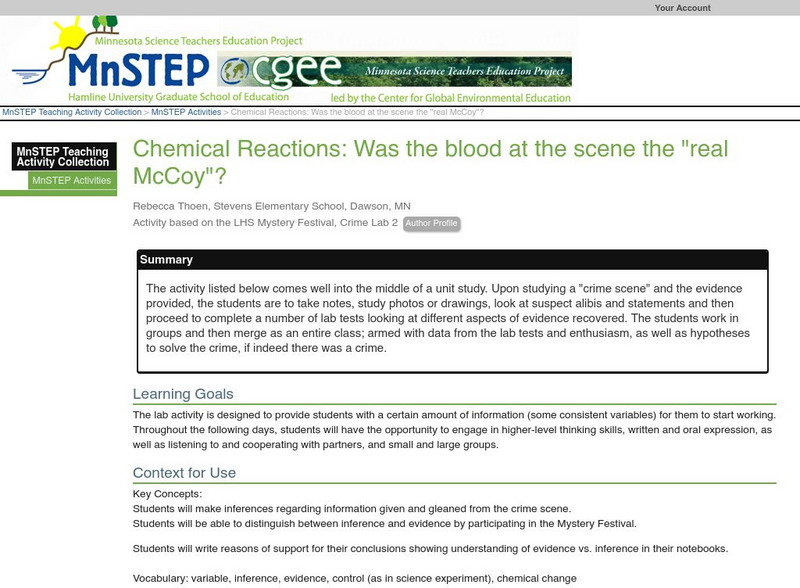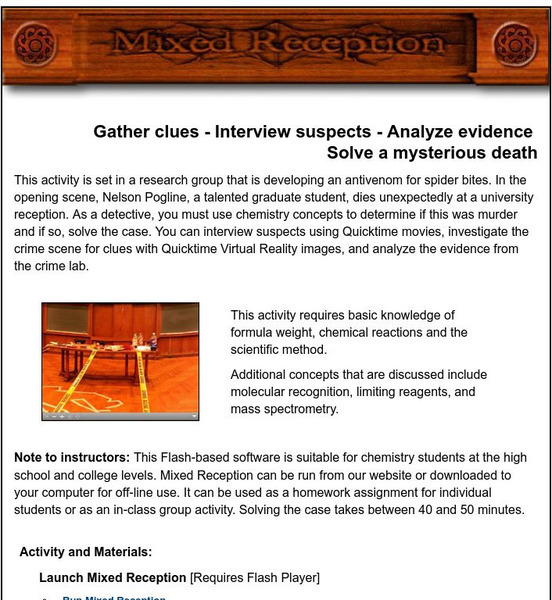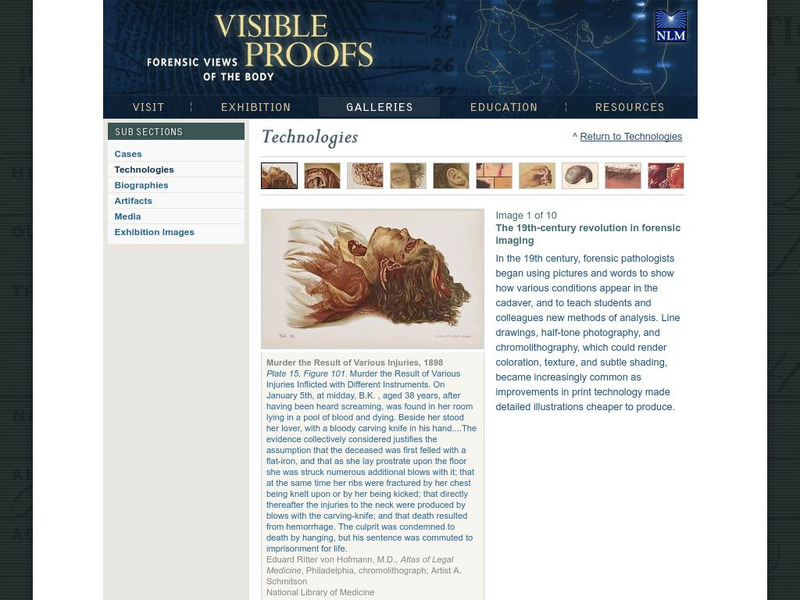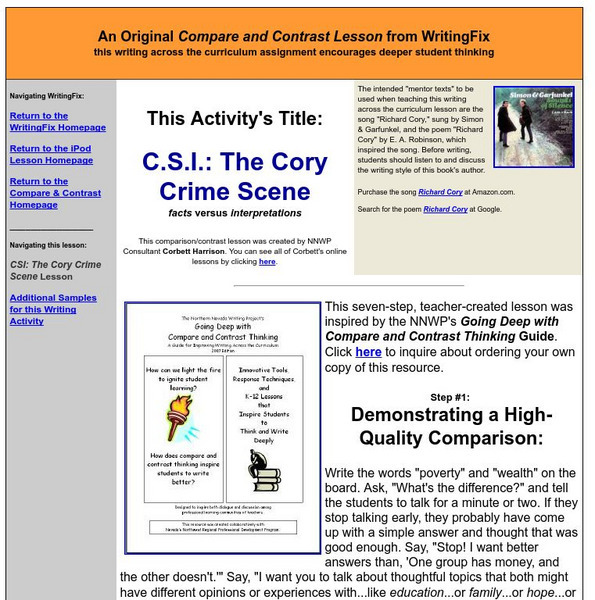Hi, what do you want to do?
Curated OER
Get a Clue: What is There and What Isn't
Students practice the ability to examine and analyze evidence and extract information that eventually leads to deductive conclusions. After evaluating the objects discovered in a box, students write a one-page reflection paper of their...
Curated OER
Not So Snappy 4
In this math worksheet, students work out the word problems in an attempt to use the skills of logic and deduction to arrive at the correct solution.
Curated OER
Using the Prefixes 're' and 'non'
In this prefixes activity, students complete 3 activities that enhance their understanding of words that contain the prefixes 're' and 'non.'
Other
Crime Scene Investigator: Searching and Examining a Major Case Crime Scene
An engrossing explanation of the appropriate behavior needed at a major crime scene. What should be done with the body? How is photography handled? What about fingerprinting? How are curious onlookers dealt with? The answers to the...
Other
Crime Scene Investigator: Evidence Collection Guidelines
A list of specific types of evidence that could be collected from a crime scene. Links to methods for collecting the following kinds of evidence: blood stains, seminal stains, hair, fibers and threads, glass, paint, flammable liquids,...
Georgia Department of Education
Ga Virtual Learning: Crime Science Investigation
In this comprehensive interactive tutorial you will learn the basic components of a crime scene investigation and how they are implemented. You will also learn various evidence collecting techniques, as well as how to properly document...
Other
Crime Scene Investigation: Protecting the Crime Scene
This brief but informative site examines how a crime scene should be protected with emphasis on the role of the first officer(s) to arrive. Points are made about the arrival of additional personnel, eating and drinking at the crime...
PBS
Pbs: Nature: Crime Scene Creatures
Become a detective with this interactive crime scene! Use tools and animals at the crime scene to help you determine the time of death of the body. By collecting specimens at the scene, students try to determine how long the person has...
Other
Crime Scene Investigator: Practical Methods for Processing a Vehicle
Practical methods are suggested to secure and not contaminate any evidence found in a vehicle at a crime scene.
Other
Crime Scene Investigator: Developing and Lifting Footwear Impressions
A thorough explanation of how to make a footwear impression at a crime scene. Topics include equipment needed, the technique used, documentation, personal safety, and more.
Virginia Tech
Virginia Tech: Precision Without Accuracy in Crime Scenes
A police forensics scientist discusses how precision will muddy the true accuracy of a crime scene. Interesting stuff. A new real world look at precision and accuracy.
NPR: National Public Radio
Npr: Photos From the Scene of the Crime
National Public Radio tells the story of the traveling display of LAPD archived photos from crime scenes as early as the 1920s, some of them "Wonderfully cinematic."
Science Education Resource Center at Carleton College
Serc: Chemical Reactions: Was the Blood at the Scene the "Real Mc Coy"?
The activity listed below comes well into the middle of a unit study. Upon studying a "crime scene" and the evidence provided, the students are to take notes, study photos or drawings, look at suspect alibis and statements and then...
Indiana University
The Case of the Missing Computer Chip
Have your teams of students solve the simulated crime scene using clues presented in this thorough forensic lesson plan.
Science Buddies
Science Buddies: Science Fair Csi: Can You Predict the Spatter?
There is evidence to be gathered at every crime scene. The hard part is making sense of it all. That's where crime scene investigators and forensic scientists come in. In this science fair project, you will investigate blood spatter...
Chemistry Collective
Chem Collective: Mixed Reception
Participate in the investigation of a virtual crime scene using chemistry concepts to solve a mysterious death. The 40-50 minute activity can be used as a classroom lab or as a homework assignment. Additionally, teachers may request a...
Other
Crime Scene Investigation: Proper Tagging and Labeling of Evidence
What is the purpose of tagging and labeling items of evidence? What information belongs on the tag? These questions are answered in this concise but competent site.
Indiana University
A Crime Against Plants
Have your students delve into the evidence involving a small tree and arrive at an explanation of what happened in this thorough lesson plan site. .
Science Buddies
Science Buddies: Project Ideas: Crime Scene Chemistry: The Light of Luminol
Experiment with the chemical called luminol, which emits a blue light when it reacts with other chemicals. This science fair project explores whether temperature affects the amount of light emitted. The Science Buddies project ideas are...
National Institutes of Health
National Library of Medicine: The Bertillon System
Bertillon devised a system to make order out of the myriad of crime scene photos taken by the police. This brief site describes how that system worked and shows a number of crime scene photos taken from Bertillon's photo album.
National Institutes of Health
National Library of Medicine: The 19th Century Revolution in Forensic Imaging
In the 19th century, forensic pathologists began to use words and pictures to describe cadavers and to teach using cadavers in the classroom. See a number of interesting photos of various crime scenes on this interesting site.
Writing Fix
Writing Fix: c.s.i.: The Cory Crime Scene
The character talked about in E. A. Robinson's poem, Richard Cory, is about a man with everything, a man that everyone wants to be like, a man who ends his own life without explanation. Singers Paul Simon and Art Garfunkel, intrigued by...
Cyberbee
Cyberbee: Who Dunnit?
If you are a crime scene investigation (CSI) fan, then you will love this site! You get to be the detective by examining the evidence, viewing the crime scene, dusting for fingerprints, interviewing the suspects, and solving the crime.
Texas Instruments
Texas Instruments: Forensics Case 8: Using Soil Characteristics to Link Suspects
In this activity, students measure pH, conductivity, and water absorbency of different samples of soil. They use these characteristic properties to identify soil samples. They use the physical and chemical characteristics of soil samples...
Other popular searches
- Crime Scene Investigator
- Crime Scene Scenarios
- Crime Scene Forensics
- Crime Scene Investigations
- Simulated Crime Scene
- Crime Scene Chromatography
- Recording the Crime Scene
- Crime Scene Analysis
- Crime Scene Investigate
- Forensics Dna Crime Scene
- Crime Scene Acidity
- Mock Crime Scenes























